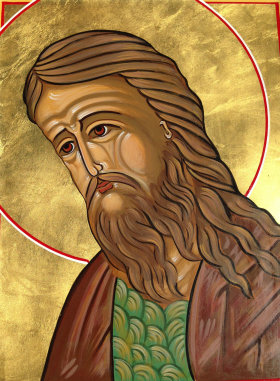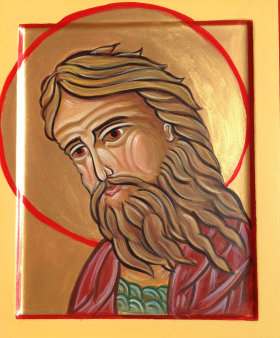Michael’s icons will be included in the display at the Twentieth Annual Icon Festival at The Basilica of Saint Mary. This event was chosen to be the public venue for completion of the Minnesota State Arts Board Folk and Traditional Arts Grant. This activity is made possible by the voters of Minnesota through a grant from the Minnesota State Arts Board, thanks to a legislative appropriation from the arts and cultural heritage fund.
The essential elements of Byzantine iconography are found in the direct teaching and oral transmission from a master to his disciple. Historical documentation has been preserved by painter’s manuals, which is a useful resource to supplement the conservatism of the tradition as carried through from master to apprentice. The great stability of the forms are encased by the Church’s vision creating a language remaining unchanged. Iconography is not an expression of one’s imagination but rather an extensive collection of symbols gathered together to create an archetype interpreted and contemplated by the onlooker who is invited to be a participant into the life of the saint or an event.
Icons indeed illustrate the freedom of each painter’s creative energies, contained within the canonical principles delegating iconographical technique. A skilled iconographer follows the tradition quite naturally even without being conscious of doing so, and without ever feeling constrained or stifled in the process. Although icons are meant to resemble one another, not any two icons will be exactly alike, each artist will express the uniqueness of his/her person through their art. Each school, each ethnic culture, each icon will carry their own identifiable characteristics.
Michael’s study allowed him the time and focus to practice and develop his skill. Skill develops through the study and practice of contemplating and painting/writing many, many icons. The art of iconography becomes a discipline and way of life as the artist strives to purify their own senses while coming closer to the mysteries of this Divine art. A manuscript on Mount Athos insists that the iconographer should “pray with tears so that God can penetrate into his/her soul.” (Evdokimov, The Art of the Icon-A Theology of Beauty, p. 177) It is even further rendered that we should paint with the “fear” of God, although yet, approach every icon with a free manner enabling every icon painter to imprint a personal character while still remaining faithful to the very spirit of the tradition. And the culture of this spirit always ready to create new life in our Lord Jesus Christ.
Here you will see 2 icons of St. John the Baptist: The first is my icon and the second is Michael’s work representing the same exact prototype as my St. John the Baptist.


This will be the closing of the apprenticeship posts. I would like to share with you a prayer from the service for Orthodoxy Sunday, the first Sunday of Great Lent, from the Greek Synodikon. It gives us remembrance to all the icon painters that have gone before us, having dedicated their lives and their skill to the grace of the Holy Spirit, who is the Divine Iconographer and Spirit of Beauty. Paul Evdokimov says it so perfectly ,” the Holy Spirit who turns all the great achievements of human culture, all of its icons, into the icon of the Kingdom.”
from Orthodoxy Sunday:
To those who know and receive the visions in the forms and figures that God Himself has given and that the prophets have seen, to those who safeguard the tradition, both written and oral, delivered by the Apostles and the fathers and mothers and who, for this reason, represent holy things in images and venerate them:to them all, memory eternal.
No comments yet.